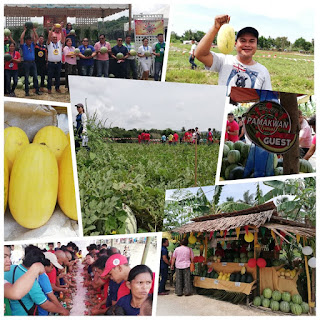Farmers in Dimiao town displayed
their watermelon of different varieties last Saturday, May 25, for the 2nd
Pamakwan Festival 2019.
The festival aims to boost
the tourism industry and to further address the importance of watermelon as the
primary product of the town.
At least 62 farmers in
Barangay Balbalan grow watermelons for extra income for the family while the
extreme heat due to the weak El Nino was drying up the land.
Balbalan, known as Bohol’s
“watermelon country,” is producing the one of the country’s sweetest and
juiciest watermelons, according to municipal agriculturist Jayrell Adanza.
Their hardwork paid off as
they showcased during the festival at least
different variety of watermelons---Sweet 16, buffalo, Diana, cantaloupe,
black panther, red and yellow delight,
and honey dew--- they vary widely in taste, texture, and color.
Watermelon season starts
from April and ends in late June or July in the country, a period when extreme
hot weather persists in parts of the country.
Adanza attributed the
distinct sweetness to the farmers’ use of saline water to irrigate the plants and the juiciness to
alluvial soil.
“It’s near the coastal
area,” said Adanza who initiated the Pamakwan Festival last year upon the
approval of Dimiao Mayor Danilo Guivencan.
Guivencan said the
festival is to give recognition among watermelon growers in the town. He hopes
an ordinance will be passed by the new administration to give full support to
the farmers.
Watermelon planting begins
in the Balbalan village on the first week of March after harvesting their palay
. They immediately prepared a total of 60 hectares of rice fields to plant
watermelons.
Some farmers started
planting in April when they have enough funds to buy farm inputs.
Seed germination to
harvest usually takes two and a half months.
Watermelon farming here
began in 1986 when a few farmers started planting pakwan in Barangay Balbalan.
It was stopped for many years since nobody was interested to buy their
products.
Farmers came back to
watermelon planting in 2000 when the demand was high.
Many health conscious people buy watermelons.
Health experts say that sufficient intake of watermelon is a perfect remedy for
a dehydrated body as it contains essential vitamins and minerals.
When other farmers made
money from watermelons, others followed, according to Carlito Galleto,
president of Dimiao Watemelon Growers Association.
Herasmo Galleto, 62,
planted watermelons in early March in his 600-square-meter farm and expected to
harvest the fruits in the first week of May. His wife, Eleuteria, 61, and their
only son Jeffrey, 18, help in the farm.
Eleuteria said she liked
planting watermelons during summer because the waiting time to make a profit
was shorter.
Although watermelons
thrive on warm weather, she said these still need to be watered twice a day.
Generally, the fruits are
ready for harvest after 70 to 80 days. One vine can produce three to five
fruits.
She said to know if the
fruits are ripe, farmers usually thump the fruits to determine ripeness. She said a hollow sound indicate that it is
right for picking.
Eleuteria and other
farmers sell the watermelons under small sheds along the highway for P30 to P35
per kilo for Sweet 16 variety and P50 for Diana variety. A sliced-cold watermelon put inside a
Styrofoam is sold at P10 per slice.
On a slow day, she could
earn P5,000 the least. When sales were
brisk, her sales could go as high as P20,000 a day.
Most of the customers are
motorists who stop at the shed. Sometimes, vendors buy in bulk and sell the
fruits in public markets in the capital city of Tagbilaran.
So far, Eleuteria said it has been financially rewarding.
“Dako gyud
ikatabang, nakapausob sabalay, nakapalit og mga gamit, ug makabayad sab sa mga
utang. Basta magkugi naa jud ((It is a big help. We improved our house, buy new
things and paid our debts. It’s just hardwork),” she said.
Carlito, 41, said he spent
P30,000 in farm inputs this planting season, including watermelon seeds,
fertilizers and chemical spray.
Luckily, he has a sales of
P200,000 before May ends.
“Bawi na kaayo mao nga
nagpasalamat mi sa Ginoo sa iyang kayo (I recovered from my investment and I thank
the Lord for his mercy),” said Carlito who started planting watermelons in
2012.
Neighboring Lila town and
even Sierra Bullones, Talibon and Ubay are also growing watermelons, but they
can’t match the number of varieties and the quality produced here, Adanza said.
Saturday’s Pamakwan
Festival was attended by the farmers, municipal officials and partners from the
provincial agriculture, private seed companies and the Agricultural Training
Institute-Regional Training Center 7 (ATI-RTC 7).
It started with field tour
that visitors and melon growers visit the farms. Visitors can directly buy
their own choice of melons from the farmers.
Dr. Carolyn May Daquio,
center director of ATI-RTC 7, said agriculture plays a big role in the community especially that
Bohol is a booming tourist destination.
She further encouraged and challenged the
youth to venture into agriculture.
“Who will feed us for the
next 10 years kung walay mutikad sa
atong kaumahan,” said Daquio.
